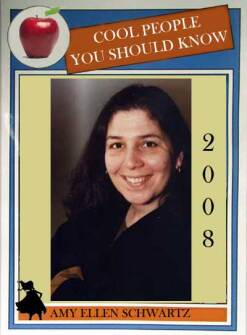
Yesterday, in eduwonkette’s bombshell revelation that she is Jennifer Jennings, a Columbia doctoral student in sociology, she explained that the timing was influenced by the fact that there was potentially damaging misinformation about her identity swirling in the blogosphere and beyond. Many people thought that eduwonkette was Amy Ellen Schwartz. Who is this Amy Ellen Schwartz? Why, she’s a cool person you should know.
Amy is the Director of the Institute for Education and Social Policy at NYU, and a Professor of Public Policy and of Education and Economics appointed both in NYU’s Wagner Graduate School of Public Service and the Steinhardt School of Culture, Education and Human Development. She’s also the President of the American Educational Finance Association, which makes her a wonk among wonks. Amy’s a New Yorker through-and-through, and through her analyses of administrative data gathered by the New York City Department of Education, she’s made important contributions to our understanding of how New York City schools serve immigrant children; strategies for measuring school performance and efficiency; and racial/ethnic differences in students’ test scores. And that’s just a sampling of her work in education; she also writes on public finance and housing.
About two weeks ago, the Census Bureau reported that the U.S. is projected to become a “majority-minority” country by 2042. New York City passed that threshold a long time ago, and few people are aware of the actual racial/ethnic make-up of the New York City public schools. About 40% of the children in the system are Hispanic; 30% are Black; 15% are Asian; and just 15% are white. At the elementary and middle-school level, one in six children was born in another country; and in a city as large and diverse as New York City, these children hail from more than 180 countries. High schools for newcomers can serve students from as many as 50 different countries.
Over the past several years, Schwartz, along with her long-time collaborator Leanna Stiefel (who is also cool, but two people wouldn’t fit on the card) and their colleagues, have sought to understand the experience of immigrant students in New York City elementary and middle schools. Two pieces of good news are that immigrant students in New York City are not, for the most part, isolated from native-born students, and that immigrant students typically attend schools that receive their fair share of school resources—largely because immigrant children are more likely to be English language learners and living in poverty than their native-born peers. Moreover, their analyses suggest that foreign-born students perform better than similar native-born students on reading and math tests, have better attendance, and are less likely to participate in part-time special education.
There is not, of course, just one immigrant experience in New York; the resources that families bring with them, and the contexts of reception they encounter when they arrive, differ across regions and countries. Moreover, what Amy and her colleagues have learned about immigrant elementary and middle school students may not apply to the experiences of immigrant high school students, and extending their analyses in this direction is definitely on their agenda.
The ways that Amy Ellen Schwartz and her colleagues have used administrative data to address fundamental questions about the performance of the New York City public schools have been a model for our masked marvel eduwonkette, and for education researchers across the country. And get this, David Cantor: an eduwonkette post on New York City that isn’t discouraging!